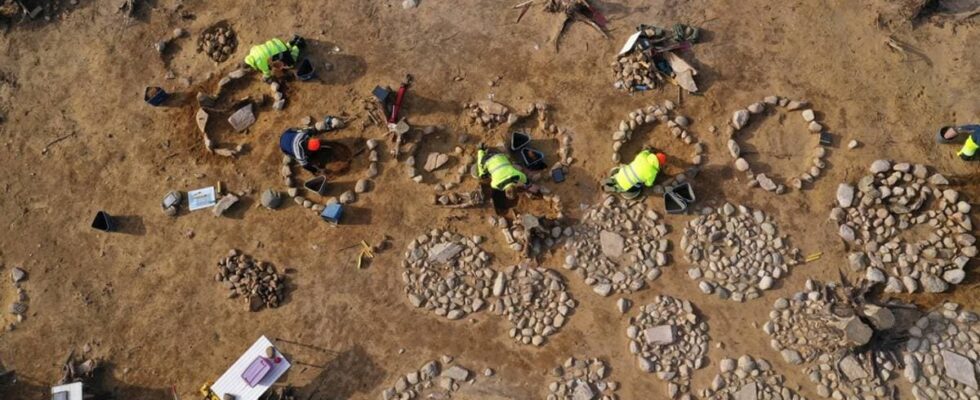The matter in summary: Archaeologists have found 40 circular stone formations with cremated bone remains in Fredrikstad. Most of the bone remains are from children, some infants and others between three and six years old. The burial site has been in use for several hundred years, from the Bronze Age to the Iron Age, i.e. between 800 and 400 years before our era. The burial field is unique in a European context and was found during an excavation in Borge in Fredrikstad municipality. The archaeologists are left with more questions than answers after the discovery, including why the children were buried in a separate place and how the tradition was kept alive over several hundred years. Only one of the graves in the field is dated to after the year 0. From then on, burial customs gradually changed, with hierarchy and large burial mounds only for those with status. The summary is made by an AI service from OpenAi. The content is quality assured by news’s journalists before publication. – These must be graves, we thought, says excavation manager Guro Fossum from the Cultural History Museum (KHM). The archaeologists were not prepared for what they would find during the excavations in Borge in Fredrikstad. None of the graves were visible in the terrain. Only after working down to 5–10 centimeters below the peat layer did they find round or oval formations between one and two meters in diameter. Archaeologist Jakob Kile-Vesik at one of the graves. In pre-Roman times, it was common for the dead to be cremated and for burnt bone remains to be buried under a flat layer of stones, usually in a spiral or wheel pattern. Photo: Kulturhistorisk museum / NTB The recent analysis results show that many of those buried were infants when they died, while others were between three and six years old. – The dating shows that the burial ground has been used over a long period of time, so they cannot all have died in the same natural disaster or in the same disease outbreak or epidemic, says Fossum. Unique find They have concluded that the burial ground has been in use for several hundred years. The children were buried between the Bronze and Iron Ages, most between 800 and 400 years before our era, i.e. up to 2,800 years ago. Further investigation revealed burnt bones, pottery shards and a possible costume buckle. All the graves were well preserved. Archaeologist Magnus Tangen secures material that can provide information. Everything must be analyzed to provide knowledge about how people lived. After the investigations, the excavation field was removed. Photo: Cultural History Museum / NTB The burial field is unique in a European context and was found during an excavation in Borge in Fredrikstad municipality last year. Fossum describes a fascinating process, where the archaeologists actually checked an area near a Stone Age settlement, but then came across one of the round stone formations. – They have been lying here as a secret, before we found them. We uncovered one by one and were left with 41 round stone layings, says the archaeologist. Several grave sites have been found, but there was something extra beguiling about this one. More questions than answers – When the analysis results ticked in, it made sense: There were small children’s graves. This has been done with so much care, says Fossum. The archaeologists still have more questions than answers after the sensational find: Why did they bury the children in a separate place? Why right here? And how did they hold on to this tradition for several hundred years? The children’s graves date from the transition between the Bronze and Iron Ages, and most were buried between 800 and 400 years before Christ. Photo: Kulturhistorisk museum / NTB – We don’t know what kind of view they had of things, why the dead were burned and buried. But it is possible that people believed that the body had to be destroyed and transformed through fire so that the soul could be freed, says Foussum. – Maybe traditions and rituals were like this to honor and remember those who had died. We do the same now: remember those who have lived before us with rituals and memorials, she adds. Only one of the graves in the field is dated to after the year 0. From then on, burial customs gradually changed, with hierarchy and large burial mounds only for those with status. Published 24.06.2024, at 08.31
ttn-69
Found over 30 mysterious children’s graves in Fredrikstad in Østfold – news Østfold – Local news, TV and radio

